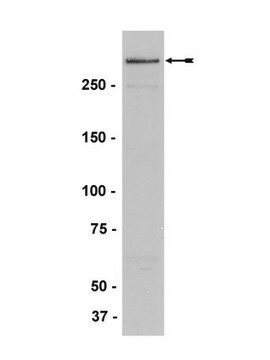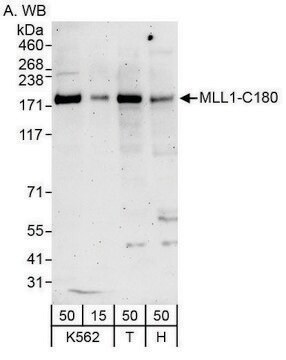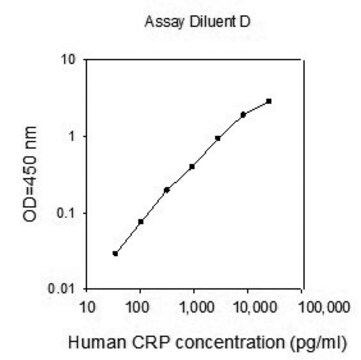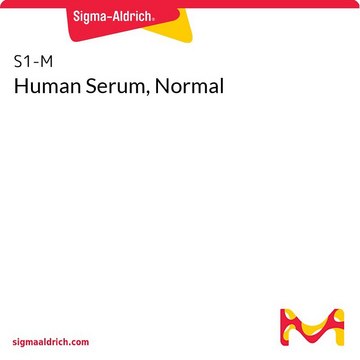05-765
Anti-MLL/HRX Antibody, CT., clone 9-12
clone 9-12, Upstate®, from mouse
Sinônimo(s):
Histone-lysine N-methyltransferase 2A, Lysine N-methyltransferase 2A, ALL-1, CXXC-type zinc finger protein 7, Myeloid/lymphoid or mixed-lineage leukemia, Myeloid/lymphoid or mixed-lineage leukemia protein 1, Trithorax-like protein, Zinc finger protein HR
About This Item
Produtos recomendados
fonte biológica
mouse
Nível de qualidade
forma do anticorpo
purified immunoglobulin
tipo de produto de anticorpo
primary antibodies
clone
9-12, monoclonal
reatividade de espécies
mouse, human
fabricante/nome comercial
Upstate®
técnica(s)
ChIP: suitable
immunofluorescence: suitable
immunoprecipitation (IP): suitable
western blot: suitable
Isotipo
IgG1
nº de adesão NCBI
nº de adesão UniProt
Condições de expedição
wet ice
modificação pós-traducional do alvo
unmodified
Informações sobre genes
human ... KMT2A(4297)
Categorias relacionadas
Descrição geral
Especificidade
Imunogênio
Aplicação
Chromatin Immnuoprecipitation (ChIP) Analysis: A representative lot detected MLL occupancy at the Hoxa10 and Meis promoters in mouse MLL-AF10 leukemia cells (Gallo, M., et al. (2013). Cancer Res. 73(1):417-427).
Chromatin Immnuoprecipitation (ChIP) Analysis: A representative lot detected an enhanced MLL occupancy at the Ink4a locus of 8-month-old than 2-month-old bEzTG mouse islets. The same age-dependent Ink4a locus enrichment was observed with H3K4me3, while the opposite trend was seen with Ezh and H3K27me3 enrichment at the same locus (Zhou, J.X., et al. (2013). J. Clin. Invest. 123(11):4849-4858).
Chromatin Immnuoprecipitation (ChIP) Analysis: A representative lot detected MLL occupancy at the HOXA10 promoter region in G179NS and G411NS human glioblastoma neural stem cells (Gallo, M., et al. (2013). Cancer Res. 73(1):417-427).
Chromatin Immnuoprecipitation (ChIP) Analysis: A representative lot detected MLL occupancy at the DNA replication origin (RD) as well as at both exon 1b and p16INK4a/p19ARF shared exon 2 in mouse embryonic fibroblast (MEF). An increased MLL enrichment at these sites was observed in senescent and Polycomb mutant MEFs (Agherbi, H., et al. (2009). PLoS One. 4(5):e5622).
Chromatin Immnuoprecipitation (ChIP) Analysis: A representative lot detected MLL occupancy at the Hoxa9 AB region using mouse embryonic fibroblast (MEF) chromatin preparation (Erfurth, F.E., et al. (2008). Proc. Natl. Acad. Sci. U.S.A. 105(21):7517-7522).
Immnuoprecipitation Analysis: A representative lot co-immunoprecipitated JmjD3 and RbBP5, but not Dnmt3a, with MLL from Min6 mouse insulinoma cell extract (Zhou, J.X., et al. (2013). J. Clin. Invest. 123(11):4849-4858).
Western Blotting Analysis: A representative lot detected higher MLL level in cultured glioblastoma neural stem (GNS) cells than neural stem (NS) cells, as well as MLL enrichment in the CD15+ fraction of freshly resected Glioblastoma (GBM) cells (Gallo, M., et al. (2013). Cancer Res. 73(1):417-427).
Western Blotting Analysis: A representative lot detected SET domain-containing C-terminal fragment of the MLL complex enzymatic subunit MLL (C180; MLLC) in anti-FLAG immunoprecipitate from HeLaS cells stably expressing FLAG-tagged hDPY-30 (Cho, Y.W., et al. (2007). J. Biol. Chem. 282(28):20395-20406).
Epigenetics & Nuclear Function
Histones
Qualidade
Western Blotting Analysis: 0.1-1 µg/mL of this antibody detected MLL C-terminal fragment (C180; MLLC) in K562 nuclear extract.
Descrição-alvo
forma física
Armazenamento e estabilidade
Nota de análise
K562 nuclear extract
Outras notas
Informações legais
Exoneração de responsabilidade
Não está encontrando o produto certo?
Experimente o nosso Ferramenta de seleção de produtos.
Código de classe de armazenamento
10 - Combustible liquids
Classe de risco de água (WGK)
WGK 1
Certificados de análise (COA)
Busque Certificados de análise (COA) digitando o Número do Lote do produto. Os números de lote e remessa podem ser encontrados no rótulo de um produto após a palavra “Lot” ou “Batch”.
Já possui este produto?
Encontre a documentação dos produtos que você adquiriu recentemente na biblioteca de documentos.
Nossa equipe de cientistas tem experiência em todas as áreas de pesquisa, incluindo Life Sciences, ciência de materiais, síntese química, cromatografia, química analítica e muitas outras.
Entre em contato com a assistência técnica








